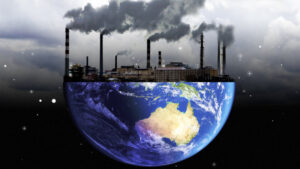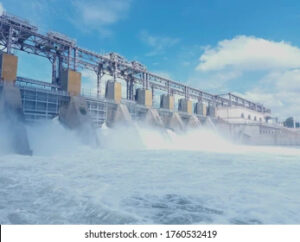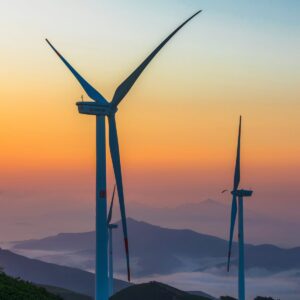Hydropower and Wind power: The Future of Green Cities

The rapid growth of population in urban areas continuously leads to the city government planning how to grow and implement essential services, housing, and infrastructure to cater to the needs of the expanding residents. It includes energy sources that are required to help run the city efficiently. In New York State, natural gas, nuclear power, and hydroelectricity have generated most of the energy since 2012 (New York State Energy Profile, 2021). As the earth’s cleanest fossil fuel, natural gas-fired electricity is used to increase reliability during the winter months. However, burning natural gas releases carbon dioxide into the atmosphere and worsens the condition of global warming. Nuclear power is also poor for the environment since it generates lots of radioactive waste that is harmful to the health of the people and the natural features of the surroundings. With the growing rate of climate change and the city’s heavy reliance on fossil fuels for energy. I reckon that switching to renewable energy resources is a more efficient way to provide and protect the environment and the people. Two sustainability options are hydropower and wind power since the city is surrounded by a large body of water and wind, which occurs naturally due to air pressure in our atmosphere. For New York City, hydropower and wind power are the best for providing energy into the city, serving the people. NYC benefits from these cost-effective and emission-free renewable energy sources.
 In a city that never sleeps and modern technology is embedded in our lifestyle. We have reached a stage where it is not feasible to not function without it. The primary source of energy that powers our society is fossil fuels. It is coal and gas formed through geological processes from the remains of living organisms. Large cities account for 80 percent of the global greenhouse emission from energy consumption despite only being 3 percent of the earth’s landmass (Satterthwaite, 2008). These non-renewable energy sources have negative impacts on the environment and living things. Some of it include water and air pollution, land degradation, long-term global warming. Children are 2,400 emergency department visits for Asthma annually, and most happen from places with higher poverty rates (Northern Manhattan, large areas of the Bronx, Central Brooklyn, parts of Eastern Queens, and the Rockaways). The New York city department of health stated that Air pollution is a leading environmental threat to the health of urban populations overall and specifically to New York City residents (Kheirbek et al., 2011). Pollution has led to the rise of illnesses affecting the lungs and heart from emission from fuel which has increased the rate of mortality. The large influx of fossil fuel power plants, huge vehicles, landfills, and poor regulated water systems concentrated in one are the causes. City expansion causes land degradation since it requires land resources to support the growth, but unsustainable use (mining, deforestation, poor water management) worsens the condition. Land degradation causes food insecurity, reduction of water quality resources, air quality, socio-cultural values, and economic development (Salehi et al., 2019).
In a city that never sleeps and modern technology is embedded in our lifestyle. We have reached a stage where it is not feasible to not function without it. The primary source of energy that powers our society is fossil fuels. It is coal and gas formed through geological processes from the remains of living organisms. Large cities account for 80 percent of the global greenhouse emission from energy consumption despite only being 3 percent of the earth’s landmass (Satterthwaite, 2008). These non-renewable energy sources have negative impacts on the environment and living things. Some of it include water and air pollution, land degradation, long-term global warming. Children are 2,400 emergency department visits for Asthma annually, and most happen from places with higher poverty rates (Northern Manhattan, large areas of the Bronx, Central Brooklyn, parts of Eastern Queens, and the Rockaways). The New York city department of health stated that Air pollution is a leading environmental threat to the health of urban populations overall and specifically to New York City residents (Kheirbek et al., 2011). Pollution has led to the rise of illnesses affecting the lungs and heart from emission from fuel which has increased the rate of mortality. The large influx of fossil fuel power plants, huge vehicles, landfills, and poor regulated water systems concentrated in one are the causes. City expansion causes land degradation since it requires land resources to support the growth, but unsustainable use (mining, deforestation, poor water management) worsens the condition. Land degradation causes food insecurity, reduction of water quality resources, air quality, socio-cultural values, and economic development (Salehi et al., 2019).
Hydropower is a renewable energy resource that requires the use of flowing water to generate electricity and power machines. It is renewable because energy is produced through the water cycle driven by the sun. Hydroelectric is important as an alternative to burning fossil fuels since it does not emit tons of greenhouse gases. As a clean energy source that does not pollute the environment like fossil fuels, it is an important energy source that should run New York City effectively. Surrounded by a large body of water, New York City can produce electricity for years for its large population. Hydropower contributes significantly to the reduction of GHG emissions and energy supply security. “Compared with conventional coal power plants, hydropower prevents the emission of about 3 GT CO2 per year, which represents about 9% of global annual CO2 emissions” (Berga, 2016).
 It can significantly reduce the immense emission in the air affecting new york residents’ lives by shortening the illness, which drops the mortality rate. It is a domestic energy resource since it does not rely on international sources makes it affordable. A properly operated hydropower electricity generation technology is considered the most inexpensive when it comes to generation cost because it does not require fuel purchase since water is available for free generally (Kaunda et al., 2012). The most inexpensive renewable energy source is hydropower and is often economically competitive with current market energy prices. It is an expensive purchase but comes with a long lifespan and a cheap cost for maintenance and operation (Berga, 2012). Though being low-price and a cleaner energy source, it still has a downside. Hydropower generation causes the disruption of river ecology, loss of biodiversity (water and land), deforestation, forced human displacement altering livelihood, and reducing the quality of the food and water systems (Moran, 2018). It is the result of poorly built dams before 1950, which are difficult to maintain and repair, so the solution is to create new ones with modern technology that combat the problems of the previous one.
It can significantly reduce the immense emission in the air affecting new york residents’ lives by shortening the illness, which drops the mortality rate. It is a domestic energy resource since it does not rely on international sources makes it affordable. A properly operated hydropower electricity generation technology is considered the most inexpensive when it comes to generation cost because it does not require fuel purchase since water is available for free generally (Kaunda et al., 2012). The most inexpensive renewable energy source is hydropower and is often economically competitive with current market energy prices. It is an expensive purchase but comes with a long lifespan and a cheap cost for maintenance and operation (Berga, 2012). Though being low-price and a cleaner energy source, it still has a downside. Hydropower generation causes the disruption of river ecology, loss of biodiversity (water and land), deforestation, forced human displacement altering livelihood, and reducing the quality of the food and water systems (Moran, 2018). It is the result of poorly built dams before 1950, which are difficult to maintain and repair, so the solution is to create new ones with modern technology that combat the problems of the previous one.

With environmental disasters caused by water dams, the alternate solution is wind power. Wind power is a renewable energy source that generates energy with the wind to provide mechanical power. It is done with wind turbines, a large device with rotor blades used to turn kinetic energy into electricity. The advantage of wind power is that it is an inexhaustible renewable energy source, so natural resources do not deplete. It does not cause water and food scarcity, unlike most electric power plants that require water consumption. The energy generated by wind turbines does not pollute the air and our water system, so it is environmentally safe for urban areas and causes fewer greenhouse gas emissions (Windexchange Wind Energy Fact Sheet, 2015). Although most people believe wind turbines are the least effective for generating electricity sustainably in a city like New York due to lack of space. We can implement it into our place without having to expand land. Wind turbines integrated into urban settings with other structures such as tall buildings, bridges, lampposts, parking areas, and more. It is an innovative use of renewable energy generation technology (Tasneem, 2020). These are various ways to use our space to provide energy and avoid encroachment and gentrification. Utilizing the surroundings instead of expanding can help avoid displacing people from their homes and prevent the destruction of natural features of the environment. “Green gentrification has implications for environmental justice because existing lower-income residents are likely to be displaced after their community is improved environmentally” (Maantay, 2018). It is common, especially in places in New York where community gardens are associated with affluent neighborhoods. In Brooklyn, New York, several sustainability plans (cleanups, restorations, and transformation) that were intended to enhance the life and health quality of the residential communities in the heavily populated borough fueled affordability issues (Hart, 2019). Inclusivity should be in the decisions made by pro-environmental organizations. Policy Makers for the city and state should prioritize poor and marginalized communities during green choices since they are mostly affected by climate change-related problems. The government and activists can tackle and address climate change and inequality social issues plaguing urban areas.
The urban areas need to implement sustainability plans into their city programs. The rate of climate change worsens every day, and the actions we take every time affect our lives. Hydropower and Wind power should be the future of generating electricity in a city that runs on modern technology. A metropolis plagued with air pollution and water contamination affecting the lives of the lower-income demographics and the environment should move its focus towards renewable energy resources. Multiple research studies have shown various methods of producing energy with little to no negative impact on the environment. It is high time we move from burning fossil fuels and relying on unethical ways to support our lifestyles. We need to reduce greenhouse gas emissions affecting the health of residents in the city and sustain our environment by including methods that support all lives on the planet. It is crucial in this age to have sustainability plans because climate change impact is worse and irreversible. By making small changes by transforming our usage of the energy source, we can have a big positive impact on the lives of all inhabitants.


